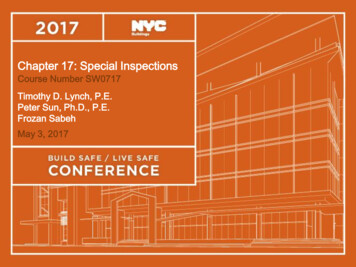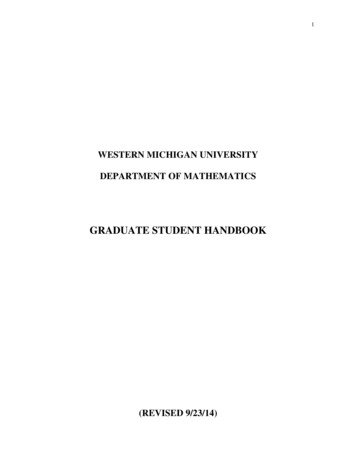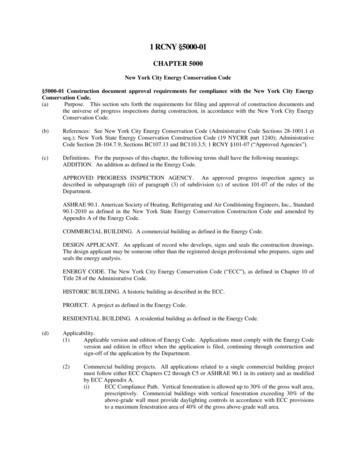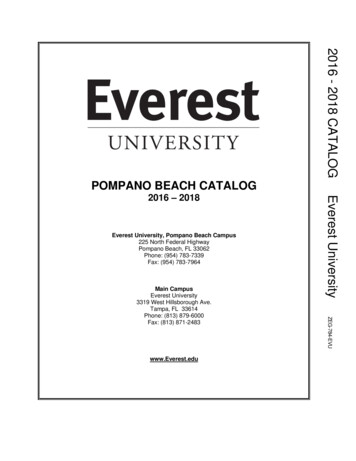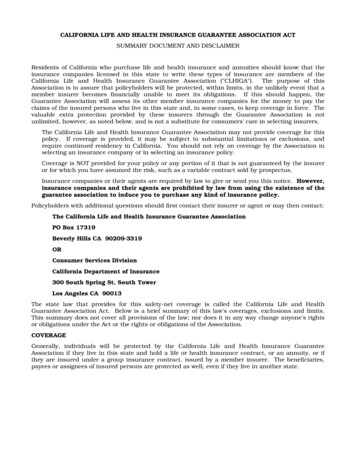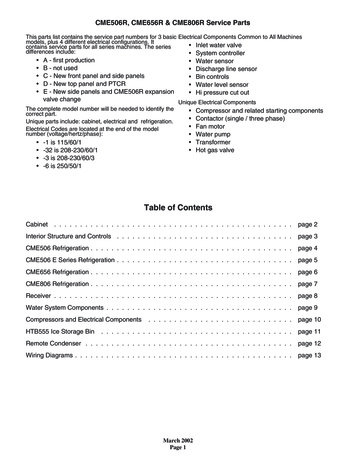
Transcription
1 RCNY §3319-01CHAPTER 3300Safeguards during Construction or Demolition§3319-01 Cranes and derricks.(a) Applicability. The design, construction, permitting, installation, removal, adjustment, repair, inspection,maintenance, operation and use of cranes and derricks must conform to the requirements of Section 3319 of theNew York City Building Code and this section. This includes, but is not limited to, cranes and derricks used forhoisting and/or rigging purposes; or used for construction, alteration, demolition, excavation and maintenancepurposes, including for buildings, highways or sewers; or used for the installation of piles; or used for the hoistingor lowering of any article on the outside of any building or structure. This also includes any equipment that meetsthe definition of a crane or derrick, including, but not limited to, dedicated pile drivers and manufactured or customdesigned hoisting machines.Exception: Cranes and derricks listed in the exceptions set forth in Section 3319.3 of the New York CityBuilding Code.(b) Definitions. For the purposes of this section, the following terms have the following meanings:ACCEPTANCE OR ACCEPTED (Construction documents). See Section 28-101.5 of the AdministrativeCode.ACCESSORY. A secondary part or assembly of parts which contributes to the overall function and usefulness ofa machine.APPOINTED. Assigned specific responsibilities by the employer or by the employer's representative.APPROVAL OR APPROVED (Construction documents). See Section 28-101.5 of the Administrative Code.ANGLE INDICATOR (boom). An accessory which measures the angle of the boom to the horizontal.ARCHITECT. A person licensed and registered to practice the profession of architecture under the education lawof the state of New York.ASSEMBLY/DISASSEMBLY (ASSEMBLED OR DISASSEMBLED). The installation or removal ofstructural components or attachments to a crane or derrick, or the installation or removal of elements that connector attach a crane or derrick to a building or structure. The term assembly/disassembly includes the erection,climbing, jumping, or dismantling of a tower crane. The term assembly/disassembly does not include operationsexclusive to the installation or removal counterweights, or to the unfolding and pinning of a boom or swing-awayjib. The term assembly/disassembly also does not include the setup or breakdown of a self-erecting tower craneprovided the setup of the self-erecting tower crane does not require a boom, mast, or jib section, or otherattachment, to be installed at the site.ATTACHMENTS. Elements that can be readily added to or removed from a crane or derrick and which expandthe range or function of the crane or derrick. Examples include, but are not limited to: an auger, boom extension,clamshell, drill, jib, jib extension, or pile-driver.AXIS OF ROTATION. The vertical axis around which the crane superstructure rotates.AXLE. The shaft or spindle with which or about which a wheel rotates. On truck and wheel mounted cranes itrefers to an automotive type of axle assembly including housing, gearing, differential, bearings and mountingappurtenances.AXLE (bogie). Two or more automotive type axles mounted in tandem in a frame so as to divide the load betweenthe axles and permit vertical oscillation of the wheels.BASE (mounting). The base or carrier on which the rotating superstructure is mounted such as a truck, crawleror platform.BOOM. A section or strut, of which the heel (lower end) is affixed to a base, carriage or support, and whose upperend supports a cable and sheaves where the load is lifted by means of wire rope and a hook.BOOM ANGLE. The angle between the longitudinal centerline of the boom and the horizontal. The boomlongitudinal centerline is a straight line between the boom foot pin (heel pin) centerline, and boom point sheavepin centerline.BOOM HARNESS. The block and sheave arrangement on the boom point to which the topping lift cable is reevedfor lowering and raising the boom.
BOOM HOIST. A hoist drum and rope reeving system used to raise and lower the boom.BOOM POINT. The outward end of the top section of the boom, containing the hoist sheave assembly.BOOM STOP. A device used to limit the angle of the boom at the highest position.BRAKE. A device used for retarding or stopping motion by friction or power means.CAB. A housing which covers the rotating superstructure machinery and/or operators station.CABLEWAY. A power operated system for moving loads in a generally horizontal direction in which the loadsare conveyed on an overhead cable, track or carriage.CERTIFICATE OF APPROVAL. A certificate issued by the department upon review and approval of theengineering and testing of a specific make and model of hoisting equipment to ensure compliance with theapplicable provisions of this code and its referenced standards.CERTIFICATE OF OPERATION. A certificate issued by the department annually upon satisfactory inspectionof the hoisting equipment holding a certificate of approval to ensure that the equipment continues to be incompliance with this code and its referenced standards.CERTIFICATE OF ON-SITE INSPECTION. A certificate issued by the department based on a site-specificapproval of the placement, founding and operation of hoisting equipment.CLAMSHELL. A shovel bucket with two jaws that clamp together by their own weight when it is lifted by aclosing line.CLIMBING/JUMPING. The raising or lowering of a tower or climber crane to different floors or levels of abuilding or structure.CLUTCH. A friction, electromagnetic, hydraulic, pneumatic or positive mechanical device for engagement ofpower.COMPETENT PERSON. One who is capable of identifying existing predictable hazards in the surroundings orconditions that are unsanitary, hazardous or dangerous, and who has authorization to take prompt correctivemeasures to eliminate such hazards.COMPONENT. A structural part or mechanical system that is integral to the crane or derrick, or an element thatsupports an integral structural part or mechanical system. Examples include, but are not limited to: a-frame,attachments, boom, boom tip, braking system, climbing frame or section, climbing mechanism, collar, counterjibs, counterweight, counterweight support system, engine, heel boom, hoist drum, hoist motor, machine deck orplatform, mast, operator’s cabin, pendant bars (excluding wire rope pendants), suspension system, tower base/baseframe, tower top, and turntable. For a derrick, a component also includes base plates, junctions, poles and otheruprights, seats, and stiff legs.COUNTERWEIGHT. Weight used to supplement the weight of the machine in providing stability for liftingworking loads.CRANE. A power-operated machine for lifting or lowering a load and moving it horizontally which utilizes wirerope and in which the hoisting mechanism is an integral part of the machine. The definition of a crane shall alsoinclude articulating boom crane, regardless of whether it has a hoisting mechanism integral to the machine.ARTICULATING BOOM CRANE. A power-operated machine for lifting or lowering a load and movingit horizontally that utilizes a boom consisting of a series of folding pin connected structural members, typicallymanipulated to extend or retract by power from hydraulic cylinders, with or without a hoisting mechanismintegral to the machine.MOBILE CRANE. A commercial truck mounted crane, crawler crane, wheel mounted crane (multiplecontrol stations), or wheel mounted crane (single control station).COMMERCIAL TRUCK MOUNTED CRANE (BOOM TRUCK). A crane consisting of a rotatingsuperstructure (center post or turntable), boom, operating machinery, and one or more operator’s stationsmounted on a frame attached to a commercial truck chassis, usually retaining a payload hauling capabilitywhose power source usually powers the crane. Its function is to lift, lower, and swing loads at variousradii.CRAWLER CRANE. A crane consisting of a rotating superstructure with a power plant, operatingmachinery, and boom, mounted on a base and equipped with crawler treads for travel. Its function is tolift, lower, and swing loads at various radii.SERVICE CRANE. A mobile crane utilized exclusively to perform one or more of the followingauxiliary tasks at a site: (1) repairing or maintaining construction machinery, (2) delivering materialwithin the confines of the site, (3) moving material within the site to a central location so that it may belifted to the required areas of construction, or (4) moving within the site matting, dunnage, or equivalentfrom one location to another. A service crane does not include a crane used to make a delivery to the site
by hoisting it into the site from a point external to the site, or a crane used to hoist or lower articles to orfrom a building or structure during the course of construction or demolition.WHEEL MOUNTED CRANE (MULTIPLE CONTROL STATIONS). A crane consisting of arotating superstructure, operating machinery, and operator’s station and boom, mounted on a crane carrierequipped with axles and rubber-tired wheels for travel, a power source(s), and having separate stationsfor driving and operating. Its function is to lift, lower, and swing loads at various radii.WHEEL MOUNTED CRANE (SINGLE CONTROL STATION). A crane consisting of a rotatingsuperstructure, operating machinery, and boom, mounted on a crane carrier equipped with axles andrubber-tired wheels for travel, a power source, and having a single control station for driving andoperating. Its function is to lift, lower, and swing loads at various radii.TOWER CRANE. A power-operated hoisting machine that utilizes a vertical tower with a rotatingsuperstructure and includes a load boom (jib) in order to lift or lower a load and move it horizontally.CLIMBER CRANE. A tower crane that can be raised to a new working height, either by adding towersections to the top of the crane (top climbing), or by a system in which the entire crane is raised insidethe structure (inside climbing).SELF-ERECTING TOWER CRANE. A tower crane that adjusts its operating radius by means of atrolley traversing a jib and that; (i) possesses a vertical or nearly vertical tower or mast that is bottomslewing and mounted on fixed, traveling, or mobile bases; and (ii) is capable of folding and unfolding tofacilitate transit from site to site with minimal assembly. A self-erecting tower crane is not considered tobe a mobile crane, even if the self-erecting tower crane otherwise meets the definition of a mobile crane.CRANE OR DERRICK NOTICE ENGINEER. The engineer, licensed and registered to practice the professionof engineering under the education law of the state of New York, who filed the crane or derrick notice application.DEDICATED PILE DRIVER. A power-operated machine that is designed primarily to drive, hammer, press,or vibrate piles into the earth (“pile drive”) and which typically possess the ability to both hoist the material thatwill be pile driven and to pile drive that material.DELIVERY. The dropping off or retrieval of materials or equipment to or from a site. Delivery does not includethe performance of any construction or demolition work, including but not limited to holding steel, HVACequipment, hoist towers, scaffolding, sidewalk shed components, or any other loads in place while they are boltedor otherwise affixed, or to the securing or lowering materials during the course of demolition work.DERRICK. An apparatus consisting of a mast or equivalent member held at the top by guys or braces, with orwithout a boom, for use with a hoisting mechanism and operating ropes, for lifting or lowering a load and movingit horizontally. The definition of a derrick includes but is not limited to: A-frame derrick, basket derrick, breastderrick, Chicago boom derrick, gin pole derrick, guy derrick, shearleg derrick, and stiffleg derrick.A-FRAME DERRICK. A derrick in which the boom is hinged from a cross member between the bottomends of two upright members spread apart at the lower ends and joined at the top; the boom point secured tothis junction of the side members, and the side members are braced or guyed from the junction point.BASKET DERRICK. A derrick without a boom, similar to a gin pole with its base supported by ropesattached to corner posts or other parts of the structure. The base is at a lower elevation than its supports. Thelocation of the base of a basket derrick can be changed by varying the length of the rope supports. The top ofthe pole is secured with multiple reeved guys to position the top of the pole to the desired location by varyingthe length of the upper guy lines. The load is raised and lowered by ropes through a sheave or block securedto the top of the pole.BREAST DERRICK. A derrick without a boom. The mast consists of two side members spread farther apartat the base than at the top and tied together at top and bottom by rigid members. The mast is prevented fromtipping forward by guys connected to its top. The load is raised and lowered by ropes through a sheave orblock secured to the top crosspiece.CHICAGO BOOM DERRICK. A derrick with a boom which is attached to a structure, an outside uprightmember of the structure serving as the mast, and the boom being stepped in a fixed socket clamped to theupright. The derrick is complete with load, boom and boom point swing line falls.GIN POLE DERRICK. A derrick that consists of a boom without a mast and which has guys arranged fromits top to permit leaning the mast in one or more directions. The load is lifted and lowered by ropes reevedthrough sheaves or blocks at the top of the mast and the lower block.GUY DERRICK. A fixed derrick consisting of a mast capable of being rotated, supported in a verticalposition by guys, and a boom whose bottom end is hinged or pivoted to move in a vertical plane with a reevedrope between the head of the mast and the boom point for raising and lowering the boom, and a reeved ropefrom the boom point for raising and lowering the load.
SHEARLEG DERRICK. A derrick without a boom. The mast, wide at the bottom and narrow at the top, ishinged at the bottom and has its top secured by a multiple reeved guy to permit handling loads at various radiiby means of load tackle suspended from the mast top.STIFFLEG DERRICK. A derrick similar to a guy derrick except that the mast is supported or held in placeby two or more stiff members, called stifflegs, which are capable of resisting either tensile or compressiveforces. Sills are generally provided to connect the lower ends of the stifflegs to the foot of the mast.DIRECT AND CONTINUING SUPERVISION. See Section 28-401.3 of the Administrative Code.DISMANTLING. The final process of taking apart, piece by piece, in a specific sequence, the components of acrane. Dismantling shall include climbing and jumping.DRUM. The cylindrical member around which a rope is wound for raising and lowering the load or boom.DYNAMIC (loading). Loads introduced into the machine or its components by forces in motion.ENGINEER. A person licensed and registered to practice the profession of engineering under the education lawof the state of New York; except that the certifications for matters relating to the manufacturer’s design andapplications for prototyping a crane or derrick may be made by an engineer who is (1) employed full time by thecrane or derrick manufacturer and (2) who is licensed to practice the profession of engineering under the law ofany state or foreign jurisdiction, or who submits proof, acceptable to the commissioner, of his or her professionalqualifications.ERECTION. The assembly and placement of crane sections and components into place, including all operationsincidental thereto. Erection shall include climbing and jumping.EXTENSION. See “Attachment.”GANTRY(A-Frame). A structural frame, extending above the superstructure of a crane, to which the boomsupport ropes are reeved.GUDGEON PIN. A pin connecting the mast cap to the mast, allowing rotation of the mast.GUY. A rope used to steady or secure the mast or other members in the desired position.HOISTING EQUIPMENT. Equipment used to raise and lower personnel and/or material with intermittentmotion. Hoisting equipment does not include scaffolds, mast climbers, and elevators.HOISTING MACHINE. A power operated machine used for lifting or lowering a load, utilizing a drum and wirerope, excluding elevators. This shall include but not be limited to a crane, derrick, and cableway and hydrauliclifting system, and articulating booms.HOISTING MECHANISM. A hoist drum and rope reeving system used for lifting and lowering loads.INDEPENDENT (peer reviewer). A person who does not engage in any activities that may conflict with theirobjective judgement or integrity, including but not limited to having a financial and/or other interest in the design,construction, installation, manufacturer, or maintenance of the crane or derrick they are reviewing.JIB. An extension attached to the boom point to provide added boom length for lifting specified loads. The jibmay be in line with the boom or offset to various angles in the vertical plane of the boom.JUMP (jumping). The process of adding or removing mast or tower sections to equipment that has already beenerected.LAY. That distance measured along a wire rope in which one strand makes one complete helical convolution aboutthe core or center.LOAD (working). The external load, in pounds (kilograms), applied to the crane or derrick, including the weightof auxiliary load attaching equipment such as load blocks, shackles, and slings.LOAD BLOCK (upper). The assembly of hook or shackle, swivel, sheaves, pins, and frame suspended from theboom point.LOAD BLOCK (lower). The assembly of hook or shackle, swivel, sheaves, pins and frame suspended by thehoisting ropes.LOAD HOIST. A hoist drum and rope reeving system used for hoisting and lowering loads.LOAD INDICATOR. A device that measures the weight of the load.LOAD MOMENT INDICATOR. A system that aids the operator by sensing (directly or indirectly) theoverturning moment of the crane or derrick. It compares this lifting condition to the equipment’s rated capacity,and indicates to the operator the percentage of capacity at which the equipment is working.LOAD MOMENT LIMITER. A system which aids the operator by sensing (directly or indirectly) theoverturning moment of the crane or derrick. It compares this lifting condition to the equipment’s rated capacity,and when the rated capacity is reached, it shuts off power to those equipment functions which can increase theseverity of loading on the equipment.LOAD RATINGS. Crane and derrick ratings in pounds (kilograms) established by the manufacturer in accordancewith standards set forth in rules promulgated by the commissioner.
LOAD RATING CHART. A full and complete range of manufacturer's crane load ratings at all stated operatingradii, boom angles, work areas, boom lengths and configurations, jib lengths and angles (or offset), as well asalternative ratings for use and nonuse of optional equipment on the crane, such as outriggers and extracounterweights, that affect ratings.MANUFACTURER. A person, firm, or corporation that (i) builds or assembles, or has built or assembled, acrane or derrick, (ii) may lawfully sell and/or distribute such crane or derrick under its own name or trademark,and (iii) provides, either by itself or through authorized representatives, replacement parts, service support,technical support, safety bulletins, and recall notices for such crane or derrick.MAST (derrick). The upright member of a derrick.MAST (boom). A frame hinged at or near the boom hinge for use in connection with supporting a boom. Thehead of the mast is usually supported and raised or lowered by the boom hoist ropes.MAST (jib). A frame hinged at or near the boom point for use in connection with supporting a jib.MAST (tower). See “Tower.”OPERATION (OPERATED). Any work or activity performed by a crane or derrick, including but not limitedto the lifting, lowering, or swinging of loads.OUTRIGGERS (crane). Extendable or fixed members attached to the mounting base that rest on supports at theouter ends used to support the crane.PILE DRIVER. A dedicated pile driver; or a crane or derrick equipped with an attachment or otherwise outfittedto drive, hammer, press, or vibrate piles into the earth (“pile drive”). However, the definition of a pile driver doesnot include excavating or earth-moving equipment fitted with a pile driving attachment.QUALIFIED (peer reviewer). A New York State professional engineer who has the education, training, andexperience required for the design of structures of a similar complexity and size as the crane or derrick noticeapplication to be peer reviewed and to perform a complete review of the means, methods, and design proposed bythe crane or derrick notice engineer.QUALIFIED PERSON. A person who by possession of a recognized degree, certificate or professional standing,or who by knowledge, training and experience, has successfully demonstrated his or her ability to solve or resolveproblems related to the subject matter, the work, or the project.REEVING. A rope system in which the rope travels around drums and sheaves.REGISTERED DESIGN PROFESSIONAL. An architect or engineer.RIGGING FOREMAN. See section 104-20 of these rules.ROPE. A continuous line of material comprised of a number of twisted or braided strands of fiber (natural orsynthetic) or metal wire.SIDE LOADING. A load applied at an angle to the vertical plane of the boom.SILL. A member connecting the foot block and stiffleg or a member connecting the lower ends of a double membermast.STANDING (GUY) ROPE. A supporting rope which maintains a constant distance between the points ofattachment to the two components connected by the rope.SUPERSTRUCTURE. The rotating upper frame structure of the machine and the operating machinery mountedthereon.SWING. Rotation of the superstructure for movement of loads in a horizontal direction about the axis of rotation.SWING MECHANISM. The machinery involved in providing rotation of the superstructure.TACKLE. An assembly of ropes and sheaves arranged for hoisting and pulling.TELESCOPIC BOOM. A boom constructed of sections of diminishing cross sections in which the sections fitwithin each other. The boom may be extended in a manner similar to a telescope.TOWER. A vertical structural frame consisting of columns and bracing that are capable of supporting workingand dynamic loads and transmitting them to the support(s).TRANSIT. The moving or transporting of a crane from one job site to another.TRAVEL. The function of the machine moving from one location to another on a job site.TRAVEL MECHANISM. The machinery involved in providing travel power.TWO-BLOCKING. A condition in which the lower load block or hook assembly comes into contact with theupper load block or boom point sheave assembly.WHEEL BASE. Distance between centers of front and rear axles. For a multiple axle assembly the axle centerwheel base measurement is taken as the midpoint of the assembly.WHIPLINE. A separate hoist rope system of lighter load capacity and higher speed than provided by the mainhoist.
WINCH HEAD. A power driven spool for handling of loads by means of friction between fiber or wire rope andspool.(c) Permit and notification requirements for cranes and derricks.(1) Certificates of approval, operation, and on-site inspection. Cranes and derricks must possess a certificateof approval, certificate of operation, and certificate of on-site inspection when required by Section 3319 ofthe Building Code.Exceptions:1. A certificate of on-site inspection is not required for:1.1 A pile driver that:1.1.1Is set up and operated entirely within a site that is closed to the public; and1.1.2Does not impart a load on the ground in excess of 500 psf (23.94 kPa), including the loadof the platform, matting, or dunnage utilized to support the equipment.1.2 A clamshell that:1.2.1Is set up and operated entirely within a site that is closed to the public;1.2.2Is set up and operated at locations within the site that are set back from the edge of theexcavation by a distance that is equal to or greater than the depth of the excavation; and1.2.3Does not impart a load on the ground in excess of 500 psf (23.94 kPa), including the loadof the platform, matting, or dunnage utilized to support the equipment.1.3 A mobile crane that has a boom length of 135 feet (41.15 m) or less, and is utilized at the siteexclusively to:1.3.1Install, adjust, maintain, repair, or remove a sidewalk shed; or1.3.2Install or dismantle the initial level of a single or dual cab hoist, provided:1.3.2.1 Such installation or dismantling is limited to the hoist cars, counterweights, andinitial mast sections needed for the car;1.3.2.2 Car or motor components to be hoisted are equipped with lifting lugs; and1.3.2.3 No object is hoisted more than 20 feet (6.1 m) above the bed of the delivery truckduring such installation or dismantling operation.2. A certificate of on-site inspection is not required for a mobile crane that is utilized under the direct andcontinuing supervision of a licensed master rigger, provided:2.1 Onsite supervision is provided by the licensee or a master rigging foreman, except that for a criticalpick the licensee must provide the onsite supervision;2.2 A drawing indicating pertinent site features, obstacles, and restrictions, the location and configurationof the crane at the site, required matting or dunnage, and pedestrian and traffic control to be providedas per the requirements of the Department of Transportation, is prepared by or on behalf of thelicensed master rigger and kept at the site, available to the commissioner upon request;2.3 The licensed master rigger is responsible for ensuring compliance with the drawing; and2.4 Such mobile crane:2.4.1Does not exceed 250 feet (76.2 m) in boom length, including jibs and any other attachments;2.4.2Is utilized for work that is not related to the construction of a new building, the fulldemolition of an existing building, or the vertical or horizontal enlargement of an existingbuilding, including but not limited to the installation or removal of boilers or tanks at a newbuilding, full demolition, or vertical or horizontal enlargement site;2.4.3In all conditions of loading, is provided with adequate footing so as to not exceed the bearingcapacity of the ground or subsurface elements;2.4.4Does not impose a bearing pressure, including dunnage, exceeding 3,500 psf (167.85 kPa);2.4.5Is not set up on a vault or similar subsurface structure;2.4.6Is not set up on a steel platform, excluding mats or dunnage at the street or ground level;and2.4.7Is not set up and operated in a location that requires approval of the New York City TransitAuthority.3. Provided an engineer, licensed and registered to practice the profession of engineering under theeducation law of the state of New York, files an on-site waiver with the department on behalf of theequipment user, supported by plans and calculations upon request, certifying compliance with the itemsspecified below, a certificate of on-site inspection is not required for:3.1 A mobile crane that:
3.1.13.1.2(2)(3)(4)(5)Is located at the site for no more than 48 hours;Does not exceed 160 feet (48.76 m) in boom length, including jibs and any otherattachments;3.1.3Is set up and operated entirely within a safety zone where the distance from the crane to theboundary of the safety zone is equal to or greater than the length of the boom, jib, and anyother attachments, and all areas and structures within the safety zone are closed to the public;and3.1.4In all conditions of loading, is provided with adequate footing so as to not exceed the bearingcapacity of the ground or subsurface elements.3.2 A service crane that:3.2.1Is set up and operated entirely within a site that is closed to the public;3.2.2Does not exceed 110 feet (33.53 m) in boom length, including jibs and any otherattachments; and3.2.3In all conditions of loading, is provided with adequate footing so as to not exceed the bearingcapacity of the ground or subsurface elements.3.3 A pile driver or clamshell that:3.3.1Is set up and operated entirely within a site that is closed to the public;3.3.2Imparts a load on the ground in excess of 500 psf (23.94 kPa) but not exceeding 2,500 psf(119.7 kPa), including the load of the platform, matting, or dunnage utilized to support theequipment;3.3.3In all conditions of loading, is provided with adequate footing so as to not exceed the bearingcapacity of the ground or subsurface elements; and3.3.4Is set up on ground that is able to support the load, as demonstrated to the satisfaction of thedepartment on the basis of borings filed by the engineer.Temporary construction equipment permit. A temporary construction equipment permit, such as an Alt IIpermit or a CD-5 permit, is required for:(i)A mobile crane that meets exception numbers 3 or 4 of Section 3319.3 of the New York City Buildingcode, but does not meet any other exception of Section 3319.3 of the New York City Building code,and is used in conjunction with the construction, alteration, or demolition of a building.(ii) Cranes and derricks with a manufacturer’s rated capacity of 1 ton (907 kg) or less and used inconjunction with the installation, alteration, maintenance, repair, or removal of a building, buildingsystems, or equipment located on a building.Noncompliance. Where a crane or derrick requiring one or more of the certificates or permits is found not tobe in compliance with one or more of the required certificates or permits, the use of such crane or derrick mustcease. The crane or derrick must not be used until it has been brought into conformance with the certificatesor permits, or amended certificates or permits have been issued by the department to reflect the state of thecrane or derrick.Construction documents. Plans, calculations, inspection reports, and oth
See Section 28-101.5 of the Administrative Code. ANGLE INDICATOR (boom). An accessory which measures the angle of the boom to the horizontal. ARCHITECT. A person licensed and registered to practice the profession of architecture under the education law of the state of New York. ASSEMBLY/DISASSEMBLY (ASSEMBLED OR DISASSEMBLED).
